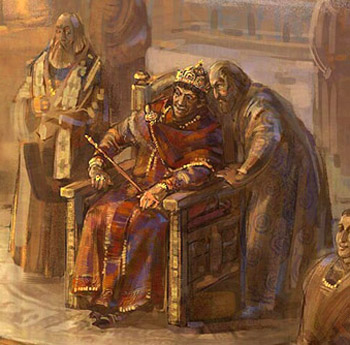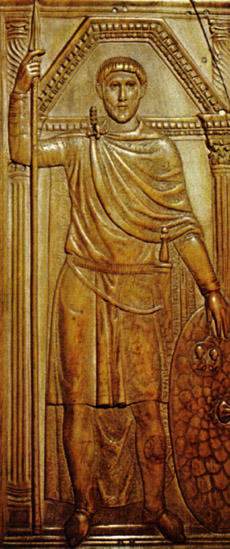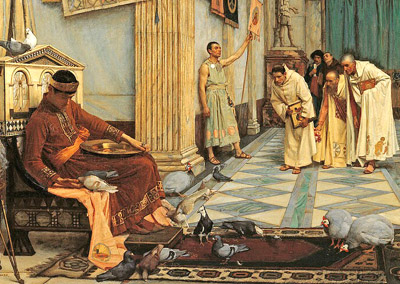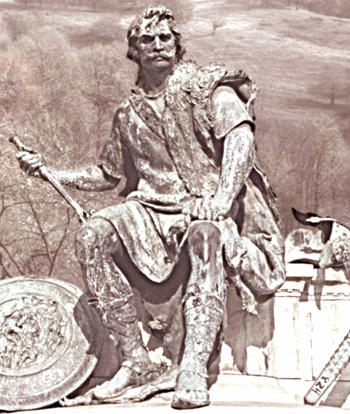Theology of History
 |
 |
 |
 |
 |
 |
 |
The Roman Empire & the Church - II
The Elites of the Empire Were Rotten
In the last article we conjectured that there was an Angel hovering over the Roman Empire protecting it; at the same time we affirmed it had fallen because it was rotten. How can this apparent contradiction be explained? In other words: Was it the whole Empire that was rotten and caused it to fall, or was it just a part of it?
Although there is not historical evidence for every single point that I will set out here, I present to you today an overview from my studies on this topic.
It was principally the elites of the Roman Empire that were rotten rather than the actual population. The mass of the people was better than the elites. We find the same situation in the history of the heresies that invaded the Church at that time, with the religious elites being more corrupt than the people.
An increasingly rotten religious elite
At the First Council of Ephesus in 431 that condemned Nestorianism, the people were much more enthused about the new glorification of Our Lady as Theotokos - the Mother of God - than most of the religious elites. When they heard the news, the people came out into the streets singing to celebrate this new title of Our Lady.
The religious elites, however, represented by the Patriarch of Constantinople, who was none other than Nestorius himself, were not pleased by the Council. In fact, Nestorius was the one who had asked the Emperor to convene that Council to prove his orthodoxy. We know that there were great saints at the time and that Nestorianism was condemned; nonetheless, a great part of the religious elite was rotten. By the time of Arianism and Semi-Arianism, that corruption had increased to the point that almost all the Bishops adhered to that heresy, and it was principally the people who held to the good doctrine.
The fallacious plots of Byzantium
We also note the same phenomenon of a corrupt elite in the high civil dignitaries, especially with its reaction to the two men that Divine Providence called to save the Roman Empire: Stilicon and Justinian.
Flavius Stilicon (359-408) was a Roman general during the reign of Honorius. He was Vandal born in today's Germany but who identified so strongly with the Roman Empire that he considered himself a Roman, entered the army and became famous for his love for Rome. Stilicon appeared in a difficult situation in Roman history: In summary, the Ostrogoths had already invaded the Empire and installed themselves in the Balkan Peninsula with the permission of the Eastern Roman Emperor. Between the years 378 and 395 they revolted against the Emperor because they wanted to have their own land.
 They came down from the Balkans toward Byzantium to make their demands before the Emperor. At that time, Byzantium was a very distinguished city, perhaps second only to Rome. It was a city of ideal beauty, extremely elegant, the archetype of a refined society, of intellectual life and the model of entertainment and arts. The Ostrogoths entering Byzantium was something much worse than, for example, the Russians entering Paris.
They came down from the Balkans toward Byzantium to make their demands before the Emperor. At that time, Byzantium was a very distinguished city, perhaps second only to Rome. It was a city of ideal beauty, extremely elegant, the archetype of a refined society, of intellectual life and the model of entertainment and arts. The Ostrogoths entering Byzantium was something much worse than, for example, the Russians entering Paris.
For this reason, the Emperor of the Eastern Empire, who was very astute in the politics of intrigue and had that fallacious way of doing things typical of the Byzantines, resolved not to combat the Ostrogoths. Realizing he lacked the necessary strength to face them in battle, he resolved to deviate the barbarians away from Byzantium and lead them to invade the Western Roman Empire instead. Toward this end, he concocted a subterfuge.
Illyria [present day Croatia, Bosnia and Albania] was a territory of contention between the Roman Empire of the West and East. At that time it was occupied by the West, but the East claimed it. So, the Eastern Roman Emperor told the Ostrogoths: "I give you the lands of Illyria. Presently it is occupied by intruders. If you put these intruders out, the land will be yours."
 So, the Ostrogoths, for whom fighting was a type of entertainment, entered Illyria and defeated the troops of the Western Emperor. Shortly after, they realized that across the Adriatic was Italy, filled with all kinds of riches, gifted with clement climate and fertile soil, and guarded by troops who were even less combative than the troops of the Eastern Roman Empire. So, the idea came to their minds of entering northern Italy by going around the Adriatic by land and crossing the Alps. This was how the Emperor of Byzantium arranged the matter.
So, the Ostrogoths, for whom fighting was a type of entertainment, entered Illyria and defeated the troops of the Western Emperor. Shortly after, they realized that across the Adriatic was Italy, filled with all kinds of riches, gifted with clement climate and fertile soil, and guarded by troops who were even less combative than the troops of the Eastern Roman Empire. So, the idea came to their minds of entering northern Italy by going around the Adriatic by land and crossing the Alps. This was how the Emperor of Byzantium arranged the matter.
At this time, General Stilicon was guarding the line of the Rhine-Danube, which marked the frontiers of the Roman Empire, separating it from the German tribes. The Emperor of the West, seeing that the barbarians were attacking northern Italy, ordered Stilicon to move his troops down to Italy to defend it. He obeyed, but this left the Rhine-Danube line unguarded.
Stilicon fought the Ostrogoths in two great battles close to the cities of Pavia and Verona. His victories were spectacular and put an end to the Ostrogoth danger. The remnants of their hordes left, settling into the territory that is today's Switzerland.
In the meantime, Visigoth tribes of various branches, seeing that Stilicon had left the Rhine-Danube frontiers unguarded, took advantage of the situation. They entered France and went down into southern Spain and even to North Africa. So, without Stilicon's presence, the Empire could not defend itself and began to lose ground.
In 406, one of the Visigoth chiefs, Radagaise, crossed the Alps and was heading toward Rome. Stilicon intervened and defeated him in Florence. Again, the Western Empire was saved by Stilicon.
With the removal of this menace, Stilicon was free to move his troops north to take on the barbarians who had invaded the Empire.
At this point, Stilicon appears in History like an Angel hovering over the Western Empire to protect it in every way possible from the barbarian hordes.
A rotten Roman court
Now then, this man who seems to have had the beautiful mission to conquer the barbarians, this man who was himself a semi-barbarian but fully assimilated into Roman culture and civilization, this man fell dead - assassinated by an order of the Western Emperor. At the height of his military career, he was vilely murdered by the order of Emperor Honorius who did not even have the care to conceal his crime.
 He ordered that crime from the fear that Stilicon himself would become emperor. It was a crime that resulted from the miserable intrigues of a decadent court, which did not understand the greatness of that man and the value of his heroism for Rome!
He ordered that crime from the fear that Stilicon himself would become emperor. It was a crime that resulted from the miserable intrigues of a decadent court, which did not understand the greatness of that man and the value of his heroism for Rome!
Stilicon proves that the Western Roman Empire did not lack great generals. It had both excellent soldiers and great generals. The main elements constituting the grandeur of Rome were her great soldiers and generals. The Empire still had them in the 4th century. What it lacked, however, was an emperor who was not petty and insignificant; it lacked a court that was not infamous and scheming, it lacked an elite that would not fail its duty in such a miserable way.
Stilicon was assassinated in the most ostensive, clear and evident way in the year 408. The Visigoths, who respected and admired Stilicon as a loyal enemy, became indignant over his murder. Either to settle the score for that vile murder or perhaps because Stilicon was no longer there to defend the Empire, they determined to invade Italy.
As a matter of fact, in 409 they did invade it with so many different hordes that the fall of the Western Roman Empire became practically inevitable. We know that in 476 the last Emperor of the West Roman Empire, Romulus Augustus, was deposed by Odoacer, who became King of Italy (467-493).
A rotten Byzantine court
In this scenario something took place that today's historians duly note, although it was ignored in the past. The barbarians revered the Roman name and believed in the idea that the world should be ruled by an Emperor. When they took over the Western Roman Empire they gathered together the symbols and insignias of the Western Empire and sent them to Zeno (425-491), the Eastern Emperor.
Their delegation told the Emperor that henceforth they considered the Empire to be one again under a single Emperor, Zeno. Thus, they made an official declaration saying that they had done away with the division of the Roman Empire into two, and considered it as one single reality as it had been before Diocletian.
 The barbarians submitted so wholly to the ideal of a single Empire that thenceforth their coins depicted the effigies of Zeno and the Eastern Emperors who followed him rather than those of their own kings. On occasions they would send embassies to Byzantium with tributes, acknowledging themselves as vassals of the Emperor.
The barbarians submitted so wholly to the ideal of a single Empire that thenceforth their coins depicted the effigies of Zeno and the Eastern Emperors who followed him rather than those of their own kings. On occasions they would send embassies to Byzantium with tributes, acknowledging themselves as vassals of the Emperor.
What was that vassalage worth? Not very much, because first, those barbarians lacked the political skills to organize their regions around the Empire, as, for example, the British Commonwealth organizes itself around the Crown of England. Second, because Zeno was such an indifferent and lazy Emperor that he did not bother to orient those barbarians to improve themselves, either spiritually or materially.
Instead of sending Catholic missionaries to convert the barbarians from Arianism, instead of trying to civilize them as the Franks ended by doing, the Emperor and that corrupt Byzantine court did nothing.
Absorbed by the feasts of Byzantium, emerged in the splendors of the Constantinople court, the Emperors were unconcerned about what they considered to be a brutal Western wilderness with its violent, light-haired hillbillies with dirty, uncoifed long hair.
Continued

Although there is not historical evidence for every single point that I will set out here, I present to you today an overview from my studies on this topic.
It was principally the elites of the Roman Empire that were rotten rather than the actual population. The mass of the people was better than the elites. We find the same situation in the history of the heresies that invaded the Church at that time, with the religious elites being more corrupt than the people.
An increasingly rotten religious elite
At the First Council of Ephesus in 431 that condemned Nestorianism, the people were much more enthused about the new glorification of Our Lady as Theotokos - the Mother of God - than most of the religious elites. When they heard the news, the people came out into the streets singing to celebrate this new title of Our Lady.
The religious elites, however, represented by the Patriarch of Constantinople, who was none other than Nestorius himself, were not pleased by the Council. In fact, Nestorius was the one who had asked the Emperor to convene that Council to prove his orthodoxy. We know that there were great saints at the time and that Nestorianism was condemned; nonetheless, a great part of the religious elite was rotten. By the time of Arianism and Semi-Arianism, that corruption had increased to the point that almost all the Bishops adhered to that heresy, and it was principally the people who held to the good doctrine.
The fallacious plots of Byzantium
We also note the same phenomenon of a corrupt elite in the high civil dignitaries, especially with its reaction to the two men that Divine Providence called to save the Roman Empire: Stilicon and Justinian.
Flavius Stilicon (359-408) was a Roman general during the reign of Honorius. He was Vandal born in today's Germany but who identified so strongly with the Roman Empire that he considered himself a Roman, entered the army and became famous for his love for Rome. Stilicon appeared in a difficult situation in Roman history: In summary, the Ostrogoths had already invaded the Empire and installed themselves in the Balkan Peninsula with the permission of the Eastern Roman Emperor. Between the years 378 and 395 they revolted against the Emperor because they wanted to have their own land.

Emperor Zeno plotted against the Western Empire
For this reason, the Emperor of the Eastern Empire, who was very astute in the politics of intrigue and had that fallacious way of doing things typical of the Byzantines, resolved not to combat the Ostrogoths. Realizing he lacked the necessary strength to face them in battle, he resolved to deviate the barbarians away from Byzantium and lead them to invade the Western Roman Empire instead. Toward this end, he concocted a subterfuge.
Illyria [present day Croatia, Bosnia and Albania] was a territory of contention between the Roman Empire of the West and East. At that time it was occupied by the West, but the East claimed it. So, the Eastern Roman Emperor told the Ostrogoths: "I give you the lands of Illyria. Presently it is occupied by intruders. If you put these intruders out, the land will be yours."
General Flavius Stilicon
At this time, General Stilicon was guarding the line of the Rhine-Danube, which marked the frontiers of the Roman Empire, separating it from the German tribes. The Emperor of the West, seeing that the barbarians were attacking northern Italy, ordered Stilicon to move his troops down to Italy to defend it. He obeyed, but this left the Rhine-Danube line unguarded.
Stilicon fought the Ostrogoths in two great battles close to the cities of Pavia and Verona. His victories were spectacular and put an end to the Ostrogoth danger. The remnants of their hordes left, settling into the territory that is today's Switzerland.
In the meantime, Visigoth tribes of various branches, seeing that Stilicon had left the Rhine-Danube frontiers unguarded, took advantage of the situation. They entered France and went down into southern Spain and even to North Africa. So, without Stilicon's presence, the Empire could not defend itself and began to lose ground.
In 406, one of the Visigoth chiefs, Radagaise, crossed the Alps and was heading toward Rome. Stilicon intervened and defeated him in Florence. Again, the Western Empire was saved by Stilicon.
With the removal of this menace, Stilicon was free to move his troops north to take on the barbarians who had invaded the Empire.
At this point, Stilicon appears in History like an Angel hovering over the Western Empire to protect it in every way possible from the barbarian hordes.
A rotten Roman court
Now then, this man who seems to have had the beautiful mission to conquer the barbarians, this man who was himself a semi-barbarian but fully assimilated into Roman culture and civilization, this man fell dead - assassinated by an order of the Western Emperor. At the height of his military career, he was vilely murdered by the order of Emperor Honorius who did not even have the care to conceal his crime.

Honorius, above, playing with pigeons and chickens, ordered the murder of General Stilicon
Stilicon proves that the Western Roman Empire did not lack great generals. It had both excellent soldiers and great generals. The main elements constituting the grandeur of Rome were her great soldiers and generals. The Empire still had them in the 4th century. What it lacked, however, was an emperor who was not petty and insignificant; it lacked a court that was not infamous and scheming, it lacked an elite that would not fail its duty in such a miserable way.
Stilicon was assassinated in the most ostensive, clear and evident way in the year 408. The Visigoths, who respected and admired Stilicon as a loyal enemy, became indignant over his murder. Either to settle the score for that vile murder or perhaps because Stilicon was no longer there to defend the Empire, they determined to invade Italy.
As a matter of fact, in 409 they did invade it with so many different hordes that the fall of the Western Roman Empire became practically inevitable. We know that in 476 the last Emperor of the West Roman Empire, Romulus Augustus, was deposed by Odoacer, who became King of Italy (467-493).
A rotten Byzantine court
In this scenario something took place that today's historians duly note, although it was ignored in the past. The barbarians revered the Roman name and believed in the idea that the world should be ruled by an Emperor. When they took over the Western Roman Empire they gathered together the symbols and insignias of the Western Empire and sent them to Zeno (425-491), the Eastern Emperor.
Their delegation told the Emperor that henceforth they considered the Empire to be one again under a single Emperor, Zeno. Thus, they made an official declaration saying that they had done away with the division of the Roman Empire into two, and considered it as one single reality as it had been before Diocletian.

The barbarians could have converted much earlier if the Eastern Roman Emperors had been faithful
What was that vassalage worth? Not very much, because first, those barbarians lacked the political skills to organize their regions around the Empire, as, for example, the British Commonwealth organizes itself around the Crown of England. Second, because Zeno was such an indifferent and lazy Emperor that he did not bother to orient those barbarians to improve themselves, either spiritually or materially.
Instead of sending Catholic missionaries to convert the barbarians from Arianism, instead of trying to civilize them as the Franks ended by doing, the Emperor and that corrupt Byzantine court did nothing.
Absorbed by the feasts of Byzantium, emerged in the splendors of the Constantinople court, the Emperors were unconcerned about what they considered to be a brutal Western wilderness with its violent, light-haired hillbillies with dirty, uncoifed long hair.
Continued

Posted February 18, 2013
______________________
______________________











